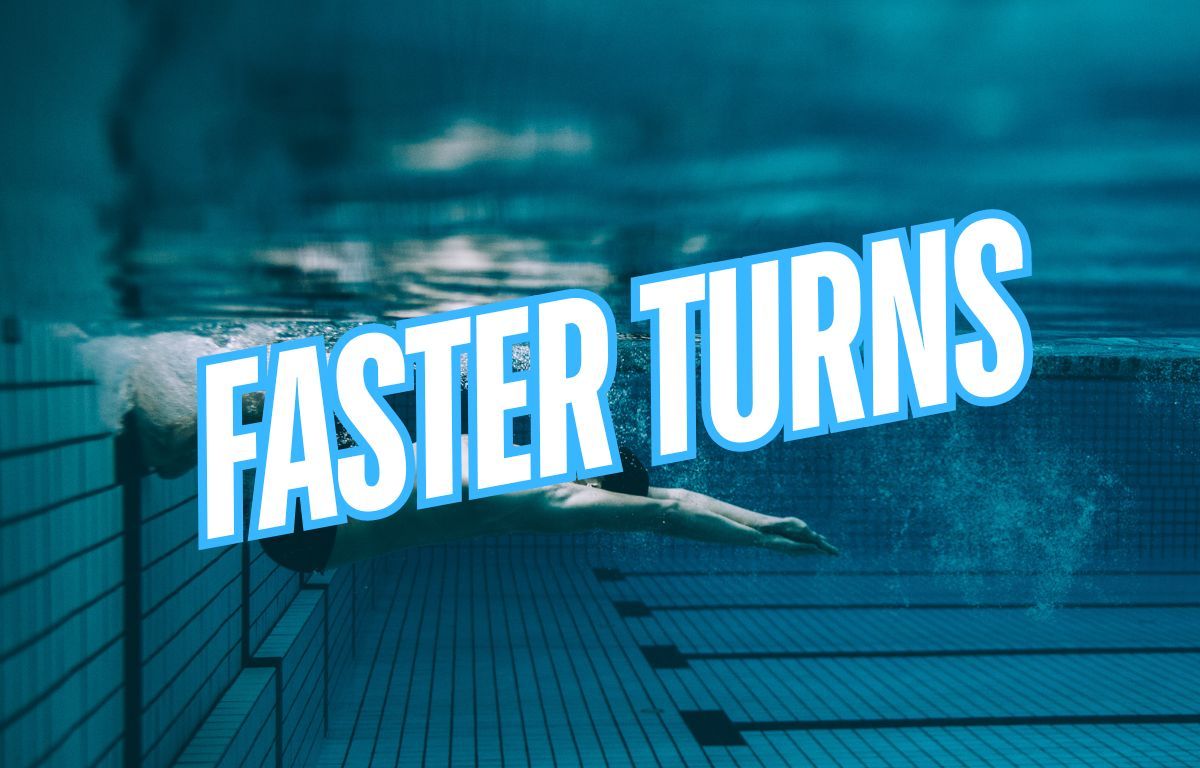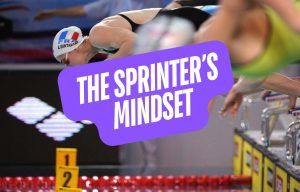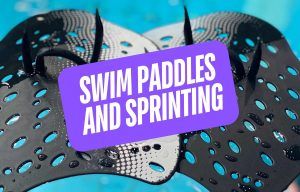Looking to improve your turns in the pool? Here are some sets, drills, and tips for faster turns and swimming.
Turns make up a significant portion of your swimming, both in training and competition, with races often won or lost on the walls.
When it comes to your own turns, are they being done with intent and focus?
Are you charging at the wall and exploding out of the turn?
Or slowly rotating through the turn at half-speed?
In this article, we will examine some of my favorite drills, sets, and mindsets for faster turns.
Using drills and sets specifically for improving turn performance can be a great way to promote better execution and turning mechanics when charging in and out of the walls.
Let’s dive in.
Tennessee turns
Tennessee turns are an underwater drill where swimmers sink below the surface of the water, and swim underwater into the wall and perform a turn.
The added resistance of the water on every part of the turn can help swimmers “feel” their way around each phase of the turn, learning how to manipulate the body in the most efficient way possible.
Alternate them with regular turns at full velocity to transfer the sharpened sense of turn mechanics and speed.
Resisted turns with DragSox
DragSox are one of my favorite tools for increasing power and speed in the pool. And while swimmers primarily use DragSox to improve kick strength, they are also excellent for increasing turn speed.
The added drag on the feet slows the legs as they initiate the flip turn or rotate the body at the wall.
Perform 3-5 turns, swimming in from 5-10m away from the wall, with DragSox and then do several without them so that swimmers can feel the extra speed without the Sox on.
Reaction flips
Reaction flips are a great drill that can be done individually or as a group. Either standing or floating, at the coach’s whistle, perform a flip turn and return to a standing (or treading water) position.
Swimmers will be required to tuck very quickly and overcome the water’s resistance to fully rotate the body.
See also: 7 Ways to Improve Flip Turn Technique
For coaches, Reaction flips are an excellent opportunity to foster healthy competition between swimmers.
Have the entire group flipping, with the slowest “out” after each round, until there is only one swimmer standing (or rather, flipping).
This fun turning drill is an opportunity for swimmers who may not be the fastest surface swimmers to shine and excel.
Mid-length 50s
Want more opportunities to improve turns? Double the number of turns within each repetition with mid-length 50s.
Mid-length 50s (or 100s if done long course) double turns by having swimmers start each repetition from the middle of the pool.
How to do it: Float to the middle of the pool. Once your interval arrives (“On the red top!”), accelerate from a dead stop and swim the 50m, performing two turns.
An example:
20×50 freestyle swim starting from the middle of the pool on 1:10
- ODDS: sprint the 5m in and out of the first turn
- EVENS: sprint the 5m in and out of the second turn
For improving medley turns, this set can be especially powerful.
I call it “rotisserie medley” as swimmers rotate quickly through two types of turns and three strokes:
20×50 rotisserie medley – From a floating start in the middle of the pool, swim butterfly to turn one, transition to backstroke, and for turn two, perform a back-to-breaststroke turn, with ensuing breaststroke pull-out back to the middle of the pool, on 1:10
The set can be fully configured to rotate through all of the strokes and types of turns.
For example:
20×50 rotisserie medley as:
- ODDS: Fly to back turn and back to breast turn
- EVENS: Back to breast turn and breast to free turn
By cycling through the different strokes and types, you get an opportunity to focus on nailing the transitions.
Mid-length 50s are an excellent way to heighten focus on turns simply by adding more of them!
Overspeed turns
Swimmers should regularly do turns at race pace or faster speeds.
Sprinting into the wall with fins on at maximum velocity and trying to time the wall can help them prepare for competitive situations.
During races, swimmers approach walls much faster than their training speeds, making them more prone to mistiming the wall.
When this happens, swimmers experience either:
The dreaded “squished cannonball turn” (where you are so close to the wall that your butt is basically resting on the bulkhead) or “extend-o-toes push-off” (where you turn too early and rely on your tippy toes to push off the wall).
Overspeed turns help swimmers learn how to perform effective flip turns when swimming at race-pace (or faster) speeds so that they can race and turn with confidence when it matters most.
How to do it: Strap on swim fins, and either sprinting 25s, or sprinting in from 15m away from the wall, attack the turn at full speed and master the timing while ripping across the pool at Mach 5.
Alternative: Swimmers can work on doing turns at high velocities by diving from the side of the pool, around 7.5-10m away from the wall, and using the speed from the dive and breakout to hit higher-than-training speeds.
Suicides with Flip Turns
Popular with track and speed athletes on the dry side of the pool, suicide sprints (also known as shuttle runs) are a running drill where athletes sprint back and forth between multiple points at increasing distances.
This drill can be used in the pool to help swimmers build short-twitch fiber and increase their ability to accelerate out of their turns.
The changes in direction, cardiovascular and muscular demands, and acceleration requirements make it perfect for “conditioning” awesome turns.
How it works: Push-off and sprint to 10m. Do a flip turn, accelerate out of the turn as quickly as possible, head back to the wall and do another flip turn. Repeat, this time to 15m. Flip and turn around. Sprint back to 20m. Back to the wall. And then sprint to the 25m wall.
Take a big breather, regain your dignity, and perform several more rounds.
Suicide sprints are an absolute killer form of HIIT training, and the sudden changes in direction and overcoming the momentum of the wave swimmers create improves acceleration and power in and out of their turns.
The final 2-3 turns of each round of this drill tightly simulates the demands of a swim race, when your legs start to feel like cement and exhaustion is overtaking you.
Increase core strength
Core training is essential for fast swimming. The core stiffens the spine, improving body position in the water. It allows swimmers to exert more power, maintain their streamline, and, yes, increase turning speed and control.
A study with elite swimmers, titled “The effects of a six-week core exercises on swimming performance of national level swimmers” found that a thrice-weekly core training program improved swim speed and time required to cover the 5m out of turns.
See also: 5 Best Dryland Exercises for Faster Swim Turns
A stronger core and faster turns make intuitive sense:
Flip turns and open turns are essentially crunch or tuck maneuvers, which can be strengthened in dryland.
Core exercises like Swiss ball tucks, reverse crunches, and eve planks are a great way for swimmers to strengthen the core so that they can snap in and out of the walls like a boss.
While core training should be a regular feature in your dryland training, emphasizing core exercises for stability and strength will improve your ability to position yourself efficiently and explode off the walls.
Attack the walls mindset
Each time you hit the pool, you have an opportunity to do a ton of turns. Over the course of a 4,000m swim workout, done in a short-course pool, swimmers perform 159 turns.
How many of those can you say are done with intention? Purpose? Great technique?
Elite swimmers make a point to maximize every opportunity they have in the pool to improve.
Turns are no different.
Use a mindset where attacking the walls with speed and precision is routine, and you won’t have to do special sets and drills to improve your turns.
You’ll simply have excellent turns by default.
Wrapping Things Up
Turns are a crucial part of swimming fast, both in training and in competition.
When you consider how much time you can shave simply by turning with intent and focus, you will start to see a staggering amount of improvement on the clock.
The best part about working your turns like they owe you money is that it’s free speed.
You simply need to focus and attack the walls.
Try out the drills, sets, and mindset discussed above, take your turns to the next level, and watch your personal best times start to shake in their boots.
More Guides on Turns:
Why You Shouldn’t Breathe Into the Walls. One of the ways to charge at the walls with more urgency is to not breathe into the turns. Here is more on the benefits of holding your breath when swimming into turns.












